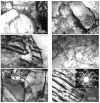Enhancing the Tensile Properties and Ductile-Brittle Transition Behavior of the EN S355 Grade Rolled Steel via Cost-Saving Processing Routes
- PMID: 38730764
- PMCID: PMC11084684
- DOI: 10.3390/ma17091958
Enhancing the Tensile Properties and Ductile-Brittle Transition Behavior of the EN S355 Grade Rolled Steel via Cost-Saving Processing Routes
Abstract
Structural rolled steels are the primary products of modern ferrous metallurgy. Consequently, enhancing the mechanical properties of rolled steel using energy-saving processing routes without furnace heating for additional heat treatment is advisable. This study compared the effect on the mechanical properties of structural steel for different processing routes, like conventional hot rolling, normalizing rolling, thermo-mechanically controlled processing (TMCP), and TMCP with accelerating cooling (AC) to 550 °C or 460 °C. The material studied was a 20 mm-thick sheet of S355N grade (EN 10025) made of low-carbon (V+Nb+Al)-micro-alloyed steel. The research methodology included standard mechanical testing and microstructure characterization using optical microscopy, scanning and transmission electronic microscopies, energy dispersive X-ray spectrometry, and X-ray diffraction. It was found that using different processing routes could increase the mechanical properties of the steel sheets from S355N to S550QL1 grade without additional heat treatment costs. TMCP followed by AC to 550 °C ensured the best combination of strength and cold-temperature resistance due to formation of a quasi-polygonal/acicular ferrite structure with minor fractions of dispersed pearlite and martensite/austenite islands. The contribution of different structural factors to the yield tensile strength and ductile-brittle transition temperature of steel was analyzed using theoretical calculations. The calculated results complied well with the experimental data. The effectiveness of the cost-saving processing routes which may bring definite economic benefits is concluded.
Keywords: EN S355; TMCP; accelerated cooling; cost-saving; hot rolling; mechanical properties; microstructure; normalizing rolling; structural steel.
Conflict of interest statement
The authors declare no conflicts of interest.
Figures












References
-
- Sun J., Hensel J., Klassen J., Nitschke-Pagel T., Dilger K. Solid-state phase transformation and strain hardening on the residual stresses in S355 steel weldments. J. Mater. Process. Technol. 2019;265:173–184. doi: 10.1016/j.jmatprotec.2018.10.018. - DOI
-
- Yu B., Chen Z., Wang P., Song X. A comparative study on the mechanical behavior of S355f steel repair-welded joints. J. Constr. Steel Res. 2023;205:107878. doi: 10.1016/j.jcsr.2023.107878. - DOI
-
- Karnaukh S.G., Markov O.E., Kukhar V.V., Shapoval A.A. Classification of steels according to their sensitivity to fracture using a synergetic model. Int. J. Adv. Manuf. Technol. 2022;119:5277–5287. doi: 10.1007/s00170-022-08653-y. - DOI
-
- Hot Rolled Products of Structural Steels—Part 1: General Technical Delivery Conditions. CEN; Brussels, Belgium: 2004.
-
- Kala Z., Valeš J. Imperfection sensitivity analysis of steel columns at ultimate limit state. Arch. Civ. Mech. Eng. 2018;18:1207–1218. doi: 10.1016/j.acme.2018.01.009. - DOI
Grants and funding
LinkOut - more resources
Full Text Sources
Research Materials

